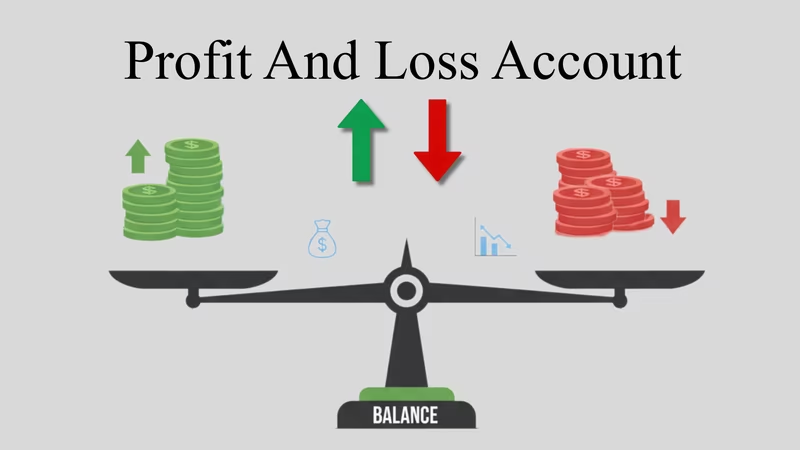Trading and Profit & Loss accounts are a company's financial statements that help the company track how a business works, the calculation of loss and profitability on a vast scale over estimated times.
These documents will be used for the company's internal matters and for the leaders, investors, and stakeholders to understand the business’s financial health.
What is a Trading Account?
A trading account is a company’s financial statement that is used to calculate the gross profit and gross loss. It records all the transactions of the business related to the direct income and expenses of the business.
The trading account is crucial in showing how efficient a business is at converting stock into revenue. This statement helps in preparing the final accounts of the business and assessing its operational performance.
Purpose of a Trading Account
The main purpose of a trading account is to
- Record all direct expenses and direct losses related to the business.
- Determine gross profit or gross loss from trading activities.
- Assess trading efficiency for a given period.
- provide data for further analysis.
Know what is gross margin and why it matters.
Key Components in the Trading Account Format
A trading account includes the following items:
- Debit Side (Expenses):
- Opening stock
- Purchases (less Purchase Returns)
- Direct expenses (Wages, Carriage Inward, Power & Fuel, Factory Rent, etc.)
- Credit Side (Income):
- Sales (less Sales Returns)
- Closing stock
After recording all these items, the difference between both sides determines Gross Profit (if credit > debit) or Gross Loss (if debit > credit).
Trading Account Format
Here is a format of a Trading account:
| Particulars | Debit (₹) | Particulars | Credit (₹) |
| Opening Stock | XXXX | Sales | XXXX |
| Purchases | XXXX | Closing Stock | XXXX |
| Wages | XXXX | ||
| Carriage Inward | XXXX | ||
| Gross Profit (b/d) | XXXX | ||
| Total | XXXX | Total | XXXX |
How to Calculate Gross Profit in a Trading Account?
The key purpose of creating a trading account is to calculate the Gross Profit or Gross Loss It shows a business's profit from selling goods before deducting indirect expenses.
Gross Profit Formula:
Gross Profit=(Sales−Sales Returns)+Closing Stock−(Opening Stock+Purchases−Purchase Returns+Direct Expenses)
Step-by-Step Calculation Example:
- Find Net Sales: Total Sales – Sales Returns
- Determine Cost of Goods Sold (COGS): Opening Stock + Purchases – Purchase Returns + Direct Expenses
- Apply the Formula: Gross Profit = Net Sales + Closing Stock – COGS
Trading Account Format Example
Now, let’s understand a Trading account with an example-
XYZ Traders has the following data for the year ending 31st March 2025:
- Opening Stock – ₹50,000
- Purchases – ₹1,00,000
- Wages – ₹20,000
- Carriage Inward – ₹5,000
- Sales – ₹2,00,000
- Closing Stock – ₹30,000
Gross Profit = (Sales + Closing Stock) – (Opening Stock + Purchases + Direct Expenses)
= (₹2,00,000 + ₹30,000) – (₹50,000 + ₹1,00,000 + ₹25,000)
= ₹2,30,000 – ₹1,75,000
= ₹55,000 (Gross Profit)
| Dr. | Cr. | ||
| Particulars | Amount (₹) | Particulars | Amount (₹) |
| Opening Stock | 50,000 | Sales | 2,00,000 |
| Purchases | 100,000 | Closing Stock | 30,000 |
| Wages | 20,000 | ||
| Carriage Inward | 5,000 | ||
| Gross Profit c/d | 55,000 | ||
| Total | 230,000 | Total | 230,000 |
What is a Profit and Loss Account?
A profit and loss account, or a P&L account, is a financial statement of operations that shows a company’s net profit or net loss over a period of time. It includes all the revenue(direct and indirect) and expenses(direct and indirect), which helps the business understand if they are in profit or loss after considering all operating costs and incomes.
The Purpose of a Profit & Loss Account
The purpose of a P&L account in a business is to
- Determine net profit or loss
- Comply with reporting standards
- Aid in financial analysis
- Facilitate decision-making
Essential Components of Profit and Loss Account
- Debit Side (Expenses):
- Salaries and Wages
- Rent and Taxes
- Office Expenses
- Depreciation
- Insurance
- Advertising
- Bad Debts
- Credit Side (Incomes):
- Gross Profit (from Trading Account)
- Discount Received
- Commission Received
- Rent or Interest Received
How to Prepare a Profit and Loss Account?
- Start with Gross Profit (from the Trading Account).
- Add all indirect incomes like interest received, commission earned, rent received, etc.
- Deduct all indirect expenses such as office rent, salaries, depreciation, insurance, and advertising.
- The result will be Net Profit (if income > expenses) or Net Loss (if expenses > income).
How do you calculate the Profit or Loss?
- Find Gross Profit from the Trading Account.
- Add Indirect Incomes (interest, commission, etc.)
- Subtract Indirect Expenses (rent, salaries, depreciation).
- If the result is positive → Net Profit;
- if negative → Net Loss.
Profit and Loss Account Format
Here is a P&L format
| Particulars | Debit (₹) | Particulars | Credit (₹) |
| Salaries | XXXX | Gross Profit b/d | XXXX |
| Rent | XXXX | Commission Received | XXXX |
| Advertising | XXXX | ||
| Depreciation | XXXX | ||
| Net Profit (c/d) | XXXX | ||
| Total | XXXX | Total | XXXX |
Profit and Loss Account Format Example
Example:
From the previous trading account, gross profit = ₹55,000
Expenses: Salaries ₹30,000, Rent ₹10,000, Advertising ₹5,000, Depreciation ₹5,000
Income: Commission ₹5,000
Net Profit = (Gross Profit + Other Incomes) – Indirect Expenses
= (₹55,000 + ₹5,000) – (₹50,000)
= ₹10,000 Net Profit
Key Formulas:
Net Profit = Total Revenue - Total Expenses
Total Revenue = Gross Profit + Other Income
Total Expenses = Operating Expenses + Indirect Expenses
Difference Between Trading and Profit and Loss Account
| Basis | Trading Account | Profit and Loss Account |
| Purpose | To find out Gross Profit or Gross Loss | To find out Net Profit or Net Loss |
| Nature of Items | Direct incomes & expenses | Indirect incomes & expenses |
| Stage | Prepared first before the Profit & Loss Account | Prepared after the trading account |
| Includes | Purchases, Sales, Wages, Closing Stock | Salaries, Rent, Depreciation, Interest |
| Result | Shows Gross Profit/Loss | Shows Net Profit/Loss |
Explore some of the challenges faced by entrepreneurs.
FAQ
What is the purpose of the trading account and profit and loss account?
The purpose of a Trading Account and a Profit & Loss Account is to determine a business’s gross profit, gross loss, net profit, or net loss for a specific accounting period.
The trading account helps measure the efficiency of core trading activities, while the profit and loss account shows the final profitability after accounting for all indirect incomes and expenses.
How do you calculate gross profit in a trading account?
Gross profit is calculated using the following formula:
Gross Profit = (Net Sales + Closing Stock) – (Opening Stock + Purchases + Direct Expenses)
If the result is negative, it indicates a Gross Loss.
What is another name given to a trading profit and loss account?
The Trading and Profit & Loss Account is often referred to as the Income Statement or Statement of Profit and Loss in modern accounting.
Who maintains a trading and profit and loss account?
A Trading and Profit & Loss Account is maintained by all businesses — from sole proprietors and partnerships to companies — that want to know their financial performance during an accounting period. It’s usually prepared by accountants or finance teams at the end of each financial year.
What is the difference between a trading account and a profit and loss account?
A trading account tracks direct revenue and expenses, which helps determine the gross profit. A profit and loss account, on the other hand, adds up taxes and running costs to find net profit.
A trading account measures how well the business is running, while the P&L account gives a full picture of the finances.
How do direct and indirect expenses affect gross and net profit?
Direct expenses (like wages, carriage inward, and power) reduce gross profit because they’re part of production or trading costs. Indirect expenses (like rent, salaries, and insurance) reduce net profit because they’re related to administration, selling, or other overheads.










